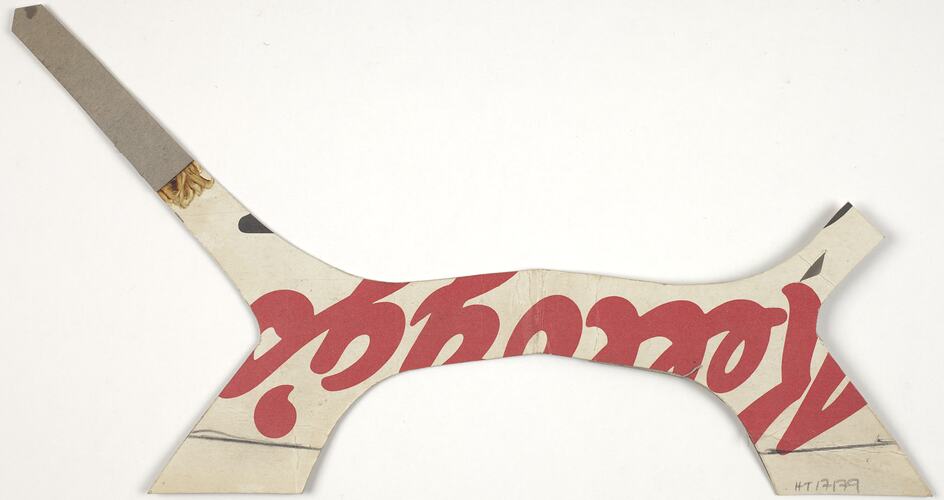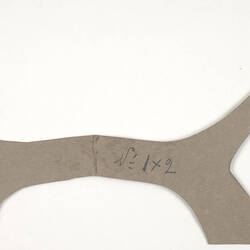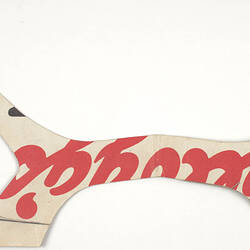Summary
Hand made woman's heel strap pattern is generated from a Kellogg's cereal cardboard box. Heel straps join the sole at the heel breast, then a thin strap hugs wearer's heel top, extending around the ankle to be fastened with a button/hole mechanism. Amongst many others, this pattern is part of the shoemaking designer kit that enabled Stanio Fancoff to acquire versatility and different fashions within his shoemaking trade from the 1930s-1970s.
Stanio Ivanoff Fancoff was born in 1908 in Bojentsi, a small village in Bulgaria. At age 11, Stanio left home to learn the shoemaking trade. In 1929, he immigrated to Melbourne, settled in Fitzroy and began to work for the V.G. Zemancheff & Sons basket shoe factory in South Melbourne. In1936, he married Dorotea Georgi Touzou who had recently arrived in Australia. Around this time, Stanio set up his own shoemaking business from home, with Georgi, her cousin and sister weaving the shoes which he then assembled. Select shoe samples were then taken to Sydney and Tasmania for sale. In 1942, Georgi and Stanio moved to Broken Hill for Georgi's health; there daughter Nancy was born and Stanio set up a shoe shop/factory. In 1945, Georgi died and by 1950 Stanio and Nancy had moved to Adelaide where he again opened a shoemaking business and shop. He passed away in 1978, having been in the shoemaking business for 59 years. This collection documents his migration and working life experiences.
Physical Description
Hand made from an Australian Kellogg's cereal cardboard box, this heel strap pattern resembles two 'Y' shapes joined at the vertical lines base and placed sideways. The lower portion is cut into thicker section, while the upper portion is thinned possibly for strapping purposes. The upper right extends approximately 12.5cm (the last 4.5cm is added white cardboard in which yellow hued glue traces remain), the left has been shortened (approx. 3.5cm length) and a triangular shaped puncture inserted, (button hole). At the pattern's centre, the piece exhibits a crease line and 'N = 1x2' is pencilled in cursive script. The reverse side is white in colour and has the tradename 'Kellogg's' printed in red across the pattern's thickest point. Top portion illustrates two pencil lines drawn horizontally, while the lengthened strap exhibits the added on piece and a brown smudging suggests an adhesive material. Although this pattern appears in good condition, it exhibits several crease such as the central fold or that located perpendicular to the triangular button hole or usage stress lines and creases as seen within the lower pattern portions.
Significance
This collection is significant in documenting a small migrant business as well as the fashion of a particular period. It is well provenanced and charts the application of trade skills in a new country. It also illustrates the stages of hand shoe manufacture from the 1930s, demonstrating the enduring nature of the tools and patterns that were used.
More Information
-
Collecting Areas
-
Acquisition Information
Donation from Nancy Vasileff, 21 Mar 2007
-
Maker
-
Inscriptions
Text: Front Face- central positioned- N= 1 x 2. Backside- central positioned- Kelloggs
-
Classification
-
Category
-
Discipline
-
Type of item
-
Overall Dimensions
261 mm (Width), 150 mm (Height)
-
References
R.A. Salaman, 'Dictionary of Leather-working Tools c.1700-1950 and Tools of Allied Trades,' London: George Allen and Unwin (Publishers) Ltd, 1986 [Section 2: Boot and Shoe Maker pp18-185]. John Peacock. 'Shoes, The Complete Sourcebook,' London:Thames & Hudson Ltd, 2005. NAA holds file (online) on Vasil George Zemancheff, Fancoff's employer
-
Keywords
Boot & Shoemaking, Bulgarian Communities, Bulgarian Immigration, Immigration, Small Businesses





